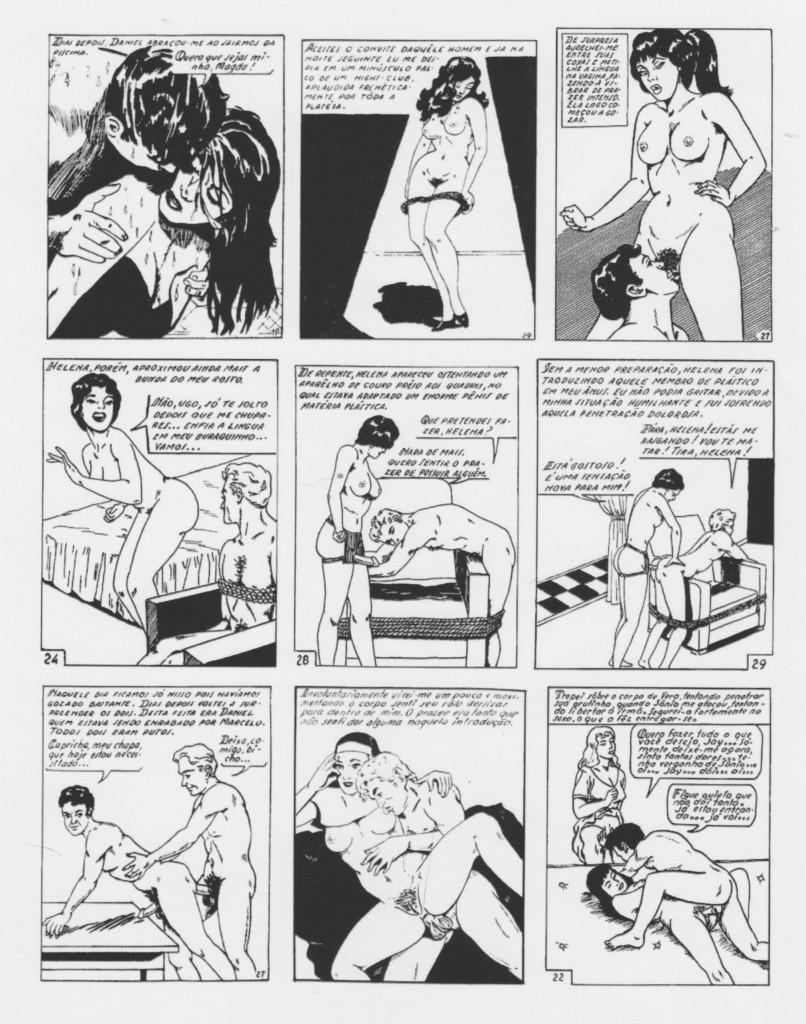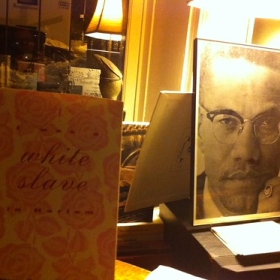Garotas de papel – Paper Girls.
Garotas de Papel – Paper Girls.
The Livros de Sacanagem of Carlos Zéfiro.
“The sun, the scanty clothing, the mixing of races, the taste of sin, all have contributed to making Brazil the most erotic land on the planet. here we show how carnival, TV, newspapers, writers, composers, and fleshy girls are all together in a conspiracy against the citizen who just wants to live his life without so much sex, sex, sex thrown down his throat.”
Rodolfo Expinoza. The Pleasure Principle.
Zéfiro = Zephyrus, the son of the Titan Astrceus and Eos, the dawn. In Ovid’s account, he husbanded Chloris, the goddess of flowers, by whom he had a son, Carpus, the god of fruit, who the Romans identified as Flora – Zephyr – the west wind, which in this case is libidinously hot and tropical. The pseudonymous Carlos Zéfiro was Bossa Nova era Brazil’s folk hero erotic artist whose 862 privately printed livros de sacanagem (filthy behavior books) are legendary. With frank sexually explicit scenes that sometimes cross over into hardcore fare, his stories combine intense philosophical insights, lunatic irreverence and animated scenes as explicit as could be found in the Hermaphroditus or on 42nd St. in that Golden Era of erotica, the 60s.
Analyzing the whole of Zéfiro’s work, we find an understanding and a telling of the thought of his time and here begins a dialogue that explores the place literature, cinema, art, music and even politics play in our sex education. His poetic vision is the only erotica by a man I have ever known women to truly enjoy. It is sex for the liberated, sex for beauty’s sake. In Zéfiro’s work we find both. Unlike pornography, this erotica is not written by idiots for perverts or visa-versa. Zéfiro’s Ars amatoria contains useful advice on courtship and seduction toward winning the mutually satisfying good love all boys and girls, men and women, desire.
In the Zéfirian oeuvre we find every possible variation of the sexual act and taboos are open subjects. The prototype of the Zéfirian adventure consists of a “first time” for the main character. This might mean a sexual position, equation, or folly; it might be adultery, inversion, trigamy, incest, or bestiality, but not all the stories are about pure lust. There are stories about being together as a couple, where the nice middle class characters fall in love and marry.
By Puritan-tainted North American standards, this is sex unconstrained by a prudish past. To their ever-loving gratitude, three generations of Brazilians got their sex educations from Zéfiro’s “catecismos.” Considered a genius, shrouded in mystery, he pseudonymously, single-handedly, drew 862 chapbooks that unintentionally managed to paint a perfect picture of the sexual liberation of the 1960s.
These are the years when the country’s right wing’s coup d’état overthrew the democratically elected progressive João Goulart for an unholy alliance between the Vatican, the CIA and the Mafia, issuing in an era of privatizing the nation’s industries and censoring the press and populace. Erotica was as high on that list as a 13 yr old boy’s.
These are also the Bossa Nova and Tropicalismo years: Antonio Carlos Jobim, Stan Getz/Joao Gilberto, Elizabeth Bishop, Jorge Amado, Oscar Niemeyer, Roberto Burle Marx, Caetano Veloso, and Gilberto Gil.
Tall and tan and young and lovely..
The Girl from Ipanema is Heloisa Eneida Menezes Paes Pinto. In our cartoonist’s imagination she is one of the models of the famous “Club dos Cafajestes” (“Sexual Rogue’s Club”) that existed in Rio de Janeiro in the lipstick and perfumed 1960s. To the lascivious mind, she’s one of those women who participated in the wild orgies promoted by the club’s thoroughly corrupt aristocracy. These are the same Big Men who would prohibit innocuous publications like Playboy and Penthouse, made Zéfiro possible.
In the 60s, women had come to pay a more important and brilliant part in Brazil’s epicurean life than they had ever done before. The Zéfirian woman: a full-bodied female, willing and open, with variations in hairstyles and outfits, sometimes drawn with Hellenic detail, only to look completely different from one frame to the next. There are several myths. One, for example, where the girls starts out young, innocent and pure, loses her virginity, and falls out of grace with society and has to flee to another city to become a stripper or a prostitute. more often, physical attraction leads to love.
The Zéfirian man: almost no variation in physical appearance, except with moustache or without, the hair always greased back. In most stories, he is the irresistible conqueror wanting to enjoy his full potential. He is also never married, but in a transition which leads him to be alone. Many times he saves the girl, who is having her troubles, through the very act of sex.
Carlos the Zephyr portrays sex as it is in real life, without false modesties, with virile poetry, blowing away hypocritical taboos and undressing the fancies. His “drawing style” of tracings from magazines, appropriations from photo-novels, old masers, and pornographers show his characters changing fom page to page. In truth, the drawings’ naive charms mattered least in the stories.The strong point is plot and script, incredibly realistic stories generally narrated in the first person, detailed narrations of amorous conquests, which culminated with a festival of sexual positions. The text was what held the attention of the readers:
*
I am a stripper and men adore to look at my naked body and they get totally obsessed with my green eyes. Men get nuts when they see my big naked tits, but I don’t let them get too close, in spite of the fact that sometimes I would really enjoy having a macho humping me. When, at the end of my show, I turn around and show them my bare ass I always get a standing ovation. My buttocks are a tremendous attraction.
*
My wedding was marvelous. Now I was anxious for that moment I would be alone with Roberto. I desired the sexual act, but I was scared of being a “SEX MANIAC.”
*
Ever since Pedro and Sulce were children they loved each other but there was something that got in their way of being a couple, “FEAR.”
*
‘Make it a special one cause today I really need it!”
‘Leave it to me, poophter.’
*
It all started when I was studying in a Catholic school. Once I told a girlfriend of mine that I wanted to be a stripper and she immediately squealed that to the Director, Father Marcelo, who called me to his office forthwith
“I’ve heard you manifested some anti-religious ideas … Do you really know what a “strip-tease” means?’
“Yes I do, Father.”
*
Ecclesiastical lust is a favored subject of the author’s catholic taste. Gay sex is sympathetically treated as only one more option in his compendium of eclectic sexual behavior. Zéfiro’s not only a passive observer relating what he sees, he is the follower of a candidly healthy libido. Zéfiro belongs to the class of 50’s libertine for whom, “at night all cats are dark and all women beautiful.”
To his readership he speaks in the language of the street with affection. He is a man of gentle and genial manners with all a poet’s feeling for life, variety and the sublety of nature. The amorist’s chief personal endowment is his vivacity, and his keen interest in and personal enjoyment of life. In delivering the various facts of life his tone of sensuous feeling is mixed with irony.
At the heart of Paper Girls is a father telling his children about sex as only someone who loves you can. it tells the coming of age stories by the shy pulp pornographer and portrays the cast of characters that inspired the Carioca Cathechismos in graphic detail. For almost forty years a man in the most absolute anonymity, hid behind the pseudonym of Carlos Zéfiro. His pamphlets started circulating around 1948 according to some and 1958 to others. and finally, in 1970, he disappeared into a shroud of mystery and legend:
- Zéfiro supposedly became rich with the money he made drawing his comics, retiring to raise chickens in a small farm in the state of Rio.
- Zéfiro died and all of his originals were burned in a fire.
- Zéfiro regretted being a porno strip artist and became an exemplary family man.
- There was not on but several Zéfiros which created in tandem and were part of the crew of a clandestine publisher controlled by the owner of a used bookstore in Rio de Janeiro.
- Zéfiro was an employee of Banco do Brazil and created the magazines after work to complement his income during a hard phase of his life and as he progressed in his “honest” job he would have left aside, once and for all, the “sacanagem” (a Brazilian expression for anything erotic or pornographic.)
- Zéfiro, the employee of a graphics shop, drew and printed his magazines after work hours, selling his product as a street vendor, putting together a clandestine distribution which covered all of Brazil.
- Zéfiro supposedly became a famous comic artist holding an Art Director position at a larg publisher that puts out children’s books.
When Zéfiro’s first works appeared he hid behind José Carlos Aguiar Caminha, a resident of Manaus, halfway up the Amazon without a paddle; a minor bureaucrat in the large bank that would employ him for most of his life. Surreptitiously, the provincial autodidact was cataloging an imaginary life, realizing it as art. In doing so Zéfiro is heir to Brasil’s tradition of the literatura de cordel (Stories on a String), an indiginous pamphletry of the poetry printed and illustrated in the tradition of the fifteenth century troubadours and the principle literature of the lower classes of Bahia.
His surreptitious chapbooks were copied on fibered newsprint on a Gestetner stencil duplicator by a newsstand dealer who would sell them from under the counter, in the time honored tradition. Not even his family knew he was the infamous pornographer. When his secret identity is revealed, Zéfiro is Alcides Caminha, an old man, exposed by a nation-wide Playboy search, who, now a Candomble priest in Rio, is launched overnight to dizzying celebrity and seemingly dies of having his anonymity violated.
Read him and reap.












